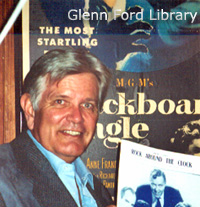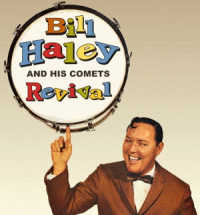|
I’ve often wondered if I’d never purchased a copy of Bill Haley and His Comets’ “Thirteen Women (And Only One Man in Town)” in 1954 how the history of Rock and Roll might have changed. Of course, if my dad hadn’t been Glenn Ford (who was the star of the film Blackboard Jungle in which the flipside of that song was featured), it wouldn’t have mattered. But I did, and he was, so I guess now the rest is just Rock and Roll history. This is my story. Rock on. Some years ago I decided to write an article about MGM Studio’s Blackboard Jungle (nominated for four Oscars at the Academy Awards in 1955) in which my father starred as teacher Richard Dadier. I had a personal connection with the film and I thought the details would be interesting. In my writing, I discussed the culture in postwar America before the production of Blackboard was received at home and abroad when it was released in March 1955. I was also looking forward to telling a bit about my participation in how the theme song of the film, “(We’re Gonna) Rock Around the Clock” (or “RATC”) by “Bill Haley and the Comets”, was used in the film. In the fall of 1954, I was a precocious fifth grader who loved music. Between the Beverly Hills Music Shop and Wallich’s Music City at Sunset and Vine, I was a busy lad indulging myself in the thing I loved most—my music. I loved rhythm and blues or “race music” as it was formerly known in the late 1940s. One of the records I bought during the fall of 1954 was “Thirteen Women (and Only One Man in Town)”, recorded by a rockabilly group called “Bill Haley and the Comets”. Earlier I had purchased my first Haley record called “Crazy Man Crazy” and knew that this Haley fellow was on to something. I looked forward to their next release. When I brought “Thirteen Women” home and played it I didn’t like it. As many kids did in those days, I turned the record over to discover the real A-side: “Rock Around the Clock.” How Decca Records could have thought that “Thirteen Women” could have been the A-side was a mystery to me. Still, “RATC” sold well, rising to number 23 on the charts before the end of the year. When I began my research to write an extensive article about Blackboard Jungle and started investigating information about “RATC,” I was quite delighted when the Internet provided me a wonderful and insightful tribute about the song and its history written by Alex Frazer-Harrison (http://www.rockabillyhall.com/RockClockTribute.html). This article had everything one would ever want to know about Bill Haley, his Comets, and the song “Rock Around the Clock.” It had everything except one thing; like every other source I found, it misidentified how the song was “discovered” and eventually used in the picture. I contacted Alex, told him what I believed to be the true story and he encouraged me to do further research to set the record straight. Bill Haley and The Comets recorded “Rock Around the Clock” on April 12, 1954 and the single was released that May. James E. Myers (a.k.a. Jimmy De Knight), who is credited with co-writing “RATC” with Max C. Freedman in 1953, said that after sales slowed on that record he sent it to many producers in Hollywood, trying to generate renewed interest in the song. This could be true, but even if he did send it around, based on the films that Pandro Berman had produced until 1954 (Morning Glory, Follow the Fleet, National Velvet and Ivanhoe to name just a few), it seems unlikely that he would have been interested in a song like “RATC.” However, I had to be sure and knew I had to locate his children to ask them. Berman had three children: Michael (b. 06/03/36), Susan (b. 12/01/41) and Cynthia (b. 07/13/42). I discussed the making of Blackboard Jungle and “RATC” with each of them. Michael remembered his dad telling him just before making the film, “You won’t believe what’s going on in the New York City school system. I’m going to do a film that will shock you.” Later, Berman played “RATC” for his children. Michael asked, “Was this written expressly for the film?” His father answered, “No, this has been out, and it was a hit.” The fact that his dad brought the record home (my copy I imagine) to play for his children was confirmed when Susan,
Berman’s eldest daughter said, “Dad came home with ‘Rock Around the Clock’ and played it for us. I loved it.” So, it wasn’t the son or at least one of Pandro’s daughters who was playing “RATC” on her record player when he first heard the song. Berman brought it home and played for them. Richard Brooks and my father would meet away from MGM during production to discuss the film. Working on a short schedule with no rehearsals with mainly non-actors was a test for everyone. Richard stopped by our house on occasion to visit Dad and talk about the production. It was on one of these visits that Richard heard some of my records. One of them was “Rock Around the Clock.” I now know that Joel Freeman, who was the assistant director on the film, recalled that toward the end of production, which would have been mid-December 1954, Brooks called him into his office to hear some records that he thought might possibly be used in the opening of the film. He played Joel three songs and they agreed that Haley’s up-tempo “jump blues” tune was the perfect choice for inclusion the film. I recently asked Joel what the other songs were but he couldn’t remember. My guess would be that in addition to “RATC” they could have been Big Joe Turner’s version of “Shake Rattle and Roll” and quite possibly “All Night Long” by the Joe Houston Orchestra. MGM eventually purchased the rights to “RATC” for $5,000 from Decca Records with the condition that they could only use the music three times in the film. It has been written that for $2,500 more they could have owned the song outright. The producer of Haley’s recording, Milt Gabler, once claimed that MGM bought the song for a dollar. Brooks, having found what he wanted, would now also use the music in the beginning of the film over the opening credits as well as at the end. Since MGM had paid for another opportunity to use the song the music department at the studio cleverly used strains and riffs from “RATC” intermixed with some jazz music during the fight scene between Dadier and his fellow teacher Josh Edwards against the gang of juvenile delinquents who attacked them in an alley. What I knew and wanted to relate before I began writing my article on Blackboard Jungle was my experience at first hearing “RATC” in the film. It was this memory that made me suspicious of all those other claims and attributions that I discovered when I began my research. “(We’re Gonna) Rock Around the Clock” was the first rock song ever to be used in a motion picture. I recently asked Evan Hunter what he thought about “RATC” being used in the film. He said, “Terrific! It started the film off with a bang. Kids were getting up and dancing in the aisles. Every kid in America went to see that film. They were carrying copies of the paperback book in the back pocket of their jeans.” And dance they did, and caused some mischief too. After a good deal of research, I now feel that I can say with certainty that I played a small, but pivotal role, in launching a musical revolution. Thanks to a unique set of circumstances, the musical passion of a fifth grader helped “RATC” become, as Dick Clark called it, “The National Anthem of Rock and Roll.” Peter Ford
Go to this address to read more about the Comets |
ROCK AROUND THE CLOCK / BLACKBOARD JUNGLE DVD
PUBLIC APPEARANCES / FAMILY PHOTOS
STARDUST MEMORIES / GLENN FORD LIBRARY & ARCHIVES
Coming soon:
Eleanor Powell Library

 By July 5, 1955, seven months after Richard Brooks first heard my 78-rpm copy of the record at my house, “RATC” was the top selling single in the nation. It stayed on the charts for eight weeks, eventually selling more than 25 million copies.
By July 5, 1955, seven months after Richard Brooks first heard my 78-rpm copy of the record at my house, “RATC” was the top selling single in the nation. It stayed on the charts for eight weeks, eventually selling more than 25 million copies.